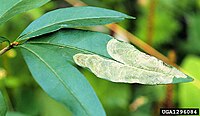en
names in breadcrumbs


Gracillaria syringella (lilac leafminer or privet leafminer) is a moth of the family Gracillariidae. It is found in Europe. It has been introduced in North America.[2]
The wingspan is 10–13 mm. The forewings are light yellowbrownish, towards base with whitish and dark fuscous strigulae ; an oblique interrupted fascia about 1/4, a somewhat angulated median fascia (sometimes followed by a small costal spot), a tornal spot, a spot on costa beyond, and costal and terminal dots near apex white, black-margined ; a blackish discal suffusion beyond middle. Hindwings are rather dark grey.The larva is whitish, sometimes greenish-tinged ; dorsal line darker green ; head brownish-tinged.[3]
The moth flies in May and again in July depending on the location.[1]
The caterpillars feed on ash (Fraxinus), privet (Ligustrum) and lilac (Syringa)[1]
Gracillaria syringella (lilac leafminer or privet leafminer) is a moth of the family Gracillariidae. It is found in Europe. It has been introduced in North America.
 Illustration from John Curtis's British Entomology Volume 6
Illustration from John Curtis's British Entomology Volume 6  Leaf mine
Leaf mine  Leaf mine
Leaf mine  Larva
Larva The wingspan is 10–13 mm. The forewings are light yellowbrownish, towards base with whitish and dark fuscous strigulae ; an oblique interrupted fascia about 1/4, a somewhat angulated median fascia (sometimes followed by a small costal spot), a tornal spot, a spot on costa beyond, and costal and terminal dots near apex white, black-margined ; a blackish discal suffusion beyond middle. Hindwings are rather dark grey.The larva is whitish, sometimes greenish-tinged ; dorsal line darker green ; head brownish-tinged.
The moth flies in May and again in July depending on the location.
The caterpillars feed on ash (Fraxinus), privet (Ligustrum) and lilac (Syringa)